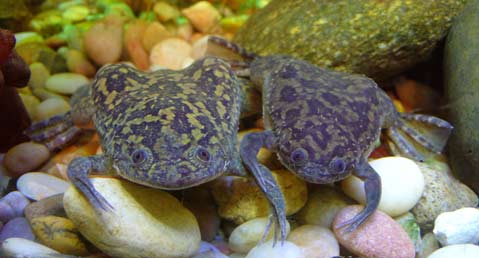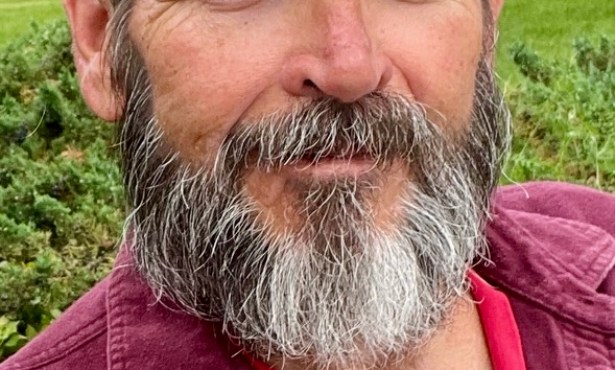Amphibians Threatened with Extinction
A Fungus May Be to Blame

Global amphibian populations have been drastically declining for the past several decades. While different causes have been suspected for causing these declines, and often extinctions, of whole species, one of the greatest causes is a fungus, specifically belonging to the chytrid group of fungi.
The amphibians include a wide variety of animals living on every continent except for Antarctica. There are three large amphibian groups: nearly 6,000 species of frogs and toads, several hundred species of salamanders, and around 200 of the lesser known caecilians (limbless, worm-like amphibians that live only in tropical regions, in the water or underground). Amphibians lay their eggs in water, where water-breathing juveniles develop and become air-breathing adults.
Amphibians have been around for a long time: 350 million years. While many have become extinct over this time, the large number of species living today clearly indicates that they’ve been very successful at surviving and thriving in changing circumstances. However, they are now declining more than ever before.
In 2004, the Global Amphibian Assessment reported that 1,856 amphibian species, nearly one third of all amphibians, were globally threatened with extinction. Additionally, based on the amazingly high, and historically unprecedented, rate at which amphibian species are becoming threatened and extinct, there may be even more catastrophic losses in this group of animals in the decades to come.
Global amphibian declines first significantly caught researchers’ attention in 1989, at the First World Congress of Herpetology (the study of amphibians and reptiles). Scientists from across the world gathered and soon found they had all been experiencing similar problems; the local amphibian populations they had been studying were disappearing. The alarmed researchers discussed possible culprits. Still under much debate to this day, there are several hypotheses for the global decline in amphibian populations: introduced species, human over-exploitation and modification of habitat areas, environmental contaminants, global warming, and infectious diseases. While it is quite likely that several of these factors play a role in each amphibian species decline, a highly infectious chytrid fungus is playing a larger role than any other suspects.
The Chytridiomycota, or chytrids, are the most primitive type of fungi and usually consume and degrade organic matter (matter that came from a living plant or animal). Their reproductive cells, or gametes, are mobile. Much like human sperm, they move around in liquid using a flagella (a long, thin, whip-like structure that acts like a propeller). They easily disseminate throughout water. These fungi are rather hardy; some chytrids have a life stage that is resistant to stressful environments and may possibly allow them to survive outside of a host for a long time.
The chytrid fungus species Batrachochytrium dendrobatidis (“Bd” for short) was found in 1998 to be responsible for parasitizing and killing its amphibian hosts (the often-fatal resultant disease is called chytridiomycosis). Although chytrids have been known to parasitize plants, algae, other fungi, single-celled organisms, and invertebrates, Bd is the first chytrid found to parasitize vertebrates. Bd is only known to use amphibians as hosts, but some hypothesize it may be able to parasitize other animals too. Bd can grow within the epidermis of the amphibian, causing the skin to thicken. While the exact process that causes death is not understood, it may be due to interfering with the amphibian’s ability to maintain a normal salt balance through its skin.
Bd has many traits contributing to its “success,” including hardiness, easy transmission between hosts, and high mortality rates of infected animals. In water with only basic, microscope organic matter to eat, Bd can live up to two months. Consequently, an infected animal can be long-dead and still infect other animals that later arrive in the area.
Additionally, several amphibian species are resistant to Bd infection, but can carry Bd and transmit the fungus to other amphibians through the water, through amphibian-to-amphibian contact, and possibly in other ways. Such Bd-resistant carriers include American bullfrogs (Rana catesbiana) and the African clawed frog (Xenopus laevis). Known aggregation of different amphibian species along with carrier species can increase the spread of Bd within an area.
In controlled laboratory studies Bd has shown extremely high mortality rates; it can rapidly kill up to 100 percent of the test amphibians.
For a long time, the origins of Bd remained a mystery, but researchers mapping Bd occurrences through time and space found an early case of Bd in a museum specimen from 1938. This animal was an African clawed frog (Xenopus laevis) in South Africa. After further research, Bd was found to have originated, most likely, as a widespread pathogen in the African clawed frogs, but was probably only localized, or endemic, to their populations in South Africa. While some researchers thought Bd may have been present but dormant throughout the world, the high genetic similarity between strains across the world suggests a single origin, in South Africa, with Xenopus.
So how did Bd leave South Africa and spread across the globe? As mentioned, Xenopus is resistant to Bd, but can serve as a carrier. For many decades, Xenopus were commercially transported across the world for pets and medical research. In fact, until the 1960s these frogs were globally used as human pregnancy tests (by injecting a pregnant woman’s urine into the lymph sac of the frog). They were, and are to this day, also widely used in basic research laboratories. Based on museum specimens, Bd is thought to have spread to other continents mostly in the 1960s and 1970s, arriving in areas right before local amphibian declines were noted.
In 2007, Bd caused the decline or extinction of up to around 200 frog species. To this day, Bd has been associated with amphibian declines on every continent where they exist, thriving most in central and South America and northern Australia, specifically in streams of the moist neotropical and tropical forests.
The biggest question now is how to prevent the spread of Bd and how to treat amphibians already infected. It appears nearly impossible to stop its spread in the wild, and even captive specimens are not safe; there have been Bd cases even in zoos. In any infected area, half of the amphibian species are expected to die within one year. The surest way to prevent spread is to not allow any outside amphibians into an area, but this may not be possible in many cases. The second best approach is to quarantine new animals for months; while amphibians show infection in 18-48 days, symptoms can take even longer than this to show.
However, there is some hope; at least one species has been coming back from near-extinction and others are recovering from less-close encounters. One somewhat successful method of treating infected amphibians is by controlling the temperature. Bd grows ideally between 63°F and 77°F, but cannot grow at 82°F and dies at 99°F. Consequently, some amphibians, such as red-eyed treefrogs (Litoria chloris), have been cured of Bd infections by enduring these high temperatures in laboratory settings. However, many amphibians cannot withstand such high temperatures. Often a treatment combining anti-fungal drugs (such as itraconazole) with heat is used on infected animals. It is suspected that some Bd-resistant frogs may secrete anti-fungal proteins on their skin, protecting them from Bd infection; much could be learned from these frogs to aid their susceptible cousins.
For more on the current extinction of amphibians by the chytrid Batrachochytrium dendrobatidis, see Lee Francis Skerratt et al.’s “Spread of Chytridiomycosis Has Caused the Rapid Global Decline and Extinction of Frogs,” James P. Collins and Martha L. Crump’s Extinction in Our Times: Global Amphibian Decline, Amphibian Ark’s Web-site page “Chytrid Fungus,” Wikipedia’s “Chytridiomycota,” and Wikipedia’s “Batrachochytrium dendrobatidis.”
Biology Bytes author Teisha Rowland is a science writer, blogger at All Things Stem Cell, and graduate student in molecular, cellular, and developmental biology at UCSB, where she studies stem cells. Send any ideas for future columns to her at science@independent.com.



